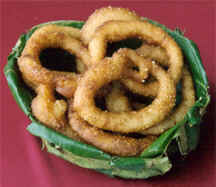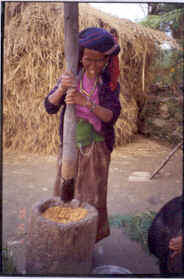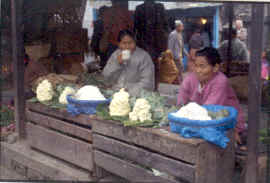Our Databases
- Helminth Parasite Spectrum in Northeast India NE
- Traditional Fermented Foods and Beverages of the Sikkim Himalayas (CLICK HERE for details)
- Medicinal Plants of Meghalaya
| The Helminth Parasitic Spectrum in Northeast India | |
Countrie |
|
| Traditional Fermented Foods and Beverages of the Sikkim Himalayas (Click Here) |
Sikkim
is a mountainous state of India with an area of 7096 sq. km and
altitudes
ranging from 300 m to 8500 m. The state comprises four districts of North, East, South and West. The total population of Sikkim is 540,493 (Census
20 01)
and comprises three major ethnic groups of people, the Nepali, the
Bhutia and
the Lepcha. The food culture of the Sikkim Himalayas is reflected in
the pattern o
01)
and comprises three major ethnic groups of people, the Nepali, the
Bhutia and
the Lepcha. The food culture of the Sikkim Himalayas is reflected in
the pattern o f
food production. Agriculture forms a major component of a mixed farming
system.
Depending on the altitudinal variation, the main agricultural crops are
rice,
maize, finger millet, wheat, buckwheat, barley, vegetable, potato,
soybeans,
large cardamom, ginger, and a variety of seasonal vegetables
such as cabbage, brinjal, chili, mustard leaves, cucumber, pumpkin,
sponge
gourd, radish, carrot, tomato, etc. Preparation of wild edible plants
including
bamboo shoots, ferns and their parts such as seeds, fruits, roots,
leaves,
flowers in local diet is an important component of food culture.
Seasonal fruits
such as orange, apple, banana, etc. are grown and eaten. Livestock
mostly plays
a subsidiary role in the mixed farming system. Cattle rearing is common
for
milk, milk products and meat. Yaks (Bos grunniens) are reared mostly on
extensive alpine and sub alpine scrub lands between 2100 m to 4500 m
altitude
for milk products and meat.
f
food production. Agriculture forms a major component of a mixed farming
system.
Depending on the altitudinal variation, the main agricultural crops are
rice,
maize, finger millet, wheat, buckwheat, barley, vegetable, potato,
soybeans,
large cardamom, ginger, and a variety of seasonal vegetables
such as cabbage, brinjal, chili, mustard leaves, cucumber, pumpkin,
sponge
gourd, radish, carrot, tomato, etc. Preparation of wild edible plants
including
bamboo shoots, ferns and their parts such as seeds, fruits, roots,
leaves,
flowers in local diet is an important component of food culture.
Seasonal fruits
such as orange, apple, banana, etc. are grown and eaten. Livestock
mostly plays
a subsidiary role in the mixed farming system. Cattle rearing is common
for
milk, milk products and meat. Yaks (Bos grunniens) are reared mostly on
extensive alpine and sub alpine scrub lands between 2100 m to 4500 m
altitude
for milk products and meat.
Traditional food fermentation is one of the oldest ‘biotechnological’ processes from which development of fermented foods, based on trial and error, is rooted in the cultural history of human being. Development of spontaneous food fermentation technology was primarily governed by agro-climatic conditions, availability of raw materials of plant and animal origin, socio-cultural ethos and ethnical preferences. During the process locally available agricultural produce are converted biochemically into upgraded edible products called fermented foods.
Traditional
fermented food has always been a rich ingredient to the Sikkimese
culture. The
Bhat-dal-tharkari-achar (rice-legume soup-curry-pickle) constitutes the
daily food supply in the meal (Tamang, 2000a ).
Daily per capita consumption of fermented foods in Sikkim is 87.6 g and
in the
Darjeeling hills, 60.9 g, representing 9.8 % and 6.8 % of the total
daily food
consumed in local diet, respectively (Yonzan and Tamang, 1998).
Selected
microorganisms harbour on to the substrates and optimum condition
provided by the
people, helps to get new products. These inexpensive culturally
acceptable
traditional foods provide basic diet
).
Daily per capita consumption of fermented foods in Sikkim is 87.6 g and
in the
Darjeeling hills, 60.9 g, representing 9.8 % and 6.8 % of the total
daily food
consumed in local diet, respectively (Yonzan and Tamang, 1998).
Selected
microorganisms harbour on to the substrates and optimum condition
provided by the
people, helps to get new products. These inexpensive culturally
acceptable
traditional foods provide basic diet as staple, adjunct, pickle, confectionery, condiment and alcoholic
beverages,
which supplement enhanced nutritional quality, palatability and
wholesomeness of
the product with acceptable flavour and texture. Varieties of
traditional
fermented and non-fermented foods are prepared, cooked and consumed in
the
Sikkim Himalayas (Tables 1 & 2). Women in these regions, using
their
indigenous knowledge of food fermentation, mostly prepare these
traditional
foods.
as staple, adjunct, pickle, confectionery, condiment and alcoholic
beverages,
which supplement enhanced nutritional quality, palatability and
wholesomeness of
the product with acceptable flavour and texture. Varieties of
traditional
fermented and non-fermented foods are prepared, cooked and consumed in
the
Sikkim Himalayas (Tables 1 & 2). Women in these regions, using
their
indigenous knowledge of food fermentation, mostly prepare these
traditional
foods.
| Medicinal Plants of Meghalaya | |
Meghalaya, the 21st state of the Indian Union, has an area of 22,429 sq km and a population of 23,06,069 (Census 2001), the higher ridges of the state lie in the coniferous belt, gradually sloping down to sub-tropical and tropical zones. Tucked away in the Northeastern region of India, it lies between 250 and 26.150 N and 89.450 and 92.470 E. The state has at present seven administrative districts-West Garo Hills, East Garo Hills, South Garo Hills, West Khasi Hills, East Khasi Hills, Ri Bhoi and Jaintia Hills.
Meghalaya is one of the richest states of India in terms of vegetation
and flora. A large |
|


 1.jpg)
 The
greatest
amount of material has been studied with regard to only some groups of
verteprates, Amphibia and mammalian livestock in particular, which have
been
devoted considerable attention. While negligibleseems to havebeen
done on this
aspect in Arunachal Pradesh, there is scanty information available on
the
distribution and abundance of helminth parasites in respects of only
some host
groups from Mizoram, Manipur and Tripura states. The present compendium
provides
a general and concise description of the helminth parasite spectrum in
Northeast
India based on the so far available information. Some of the parasite
species
recorded from animal host acquire added signifacance, as they are known
to cause
zoonoses.
The
greatest
amount of material has been studied with regard to only some groups of
verteprates, Amphibia and mammalian livestock in particular, which have
been
devoted considerable attention. While negligibleseems to havebeen
done on this
aspect in Arunachal Pradesh, there is scanty information available on
the
distribution and abundance of helminth parasites in respects of only
some host
groups from Mizoram, Manipur and Tripura states. The present compendium
provides
a general and concise description of the helminth parasite spectrum in
Northeast
India based on the so far available information. Some of the parasite
species
recorded from animal host acquire added signifacance, as they are known
to cause
zoonoses. variation in the altitude, topographical features,
soil characteristics and climatic factors has favoured the growth and
luxuriance of the rich flora here. Meghalaya is endowed with a rich
variety of beauty in nature. Of the 17,000 species of orchids in the
World, about 1,250 exist in India; about 700 species are distributed in
the northeastern states, of which nearly 352 are found in
Meghalaya.
variation in the altitude, topographical features,
soil characteristics and climatic factors has favoured the growth and
luxuriance of the rich flora here. Meghalaya is endowed with a rich
variety of beauty in nature. Of the 17,000 species of orchids in the
World, about 1,250 exist in India; about 700 species are distributed in
the northeastern states, of which nearly 352 are found in
Meghalaya.